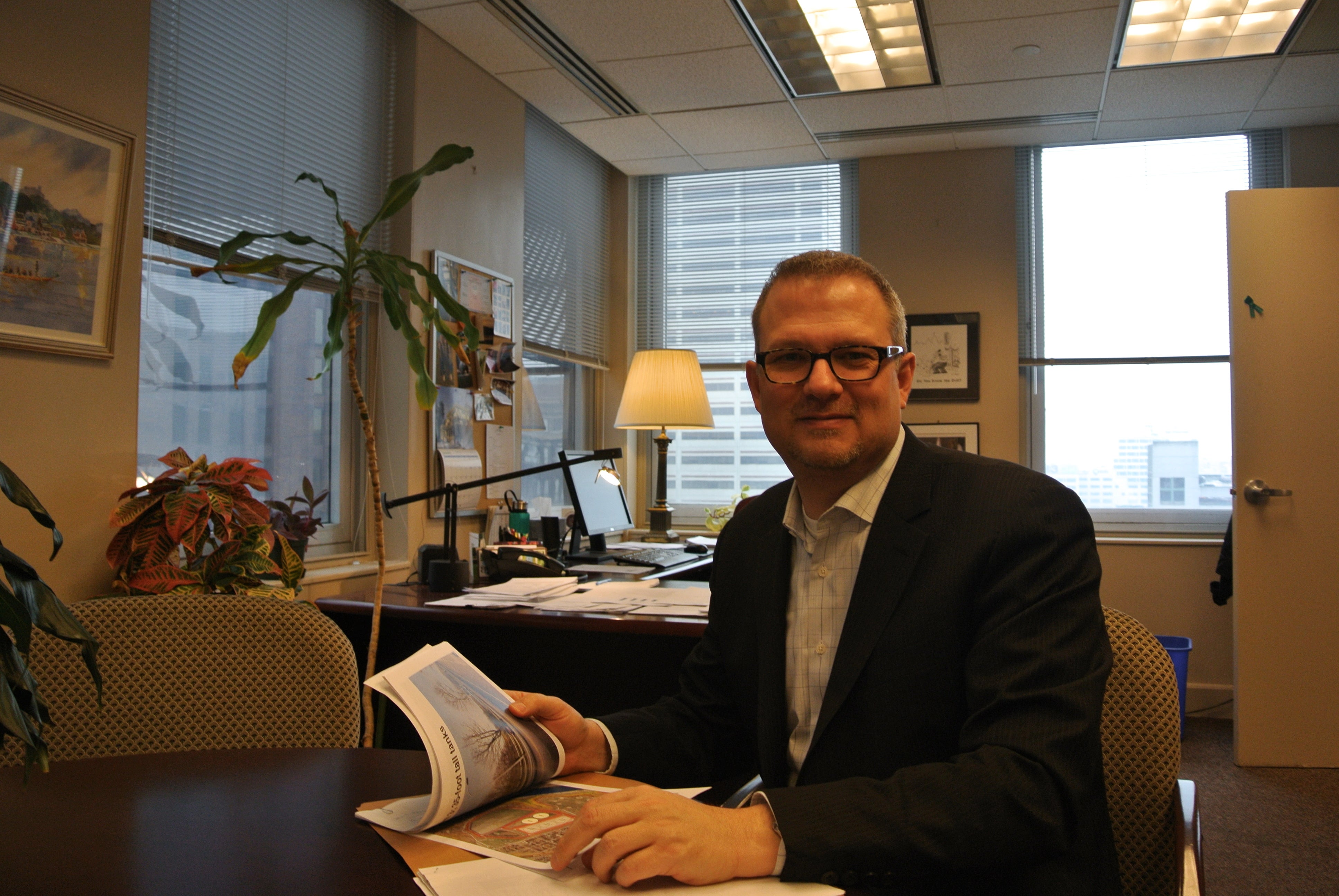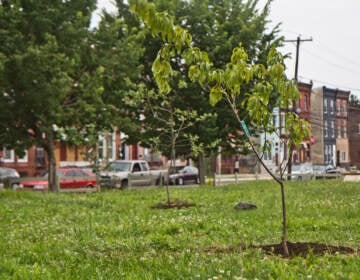In Profile: Mark Focht merges concrete and verdant jungles

Mark Focht long ago figured out how he got to where he is today: first deputy commissioner, Department of Parks and Recreation for Philadelphia, and president-elect of the American Society of Landscape Architects. And, in the same considered and dispassionate manner that he brings to his public appearances, he’s learned to succinctly recap that trajectory.
“I grew up in Allentown in a very urban setting,” he says, as we sit in his rather dark, 10th floor office at 1515 Arch Street. (He’s a stickler for natural light, even on mornings when a brooding sky signals impending snow.) “It was a rowhouse environment, so we did our playing in alleys and schoolyards.” Except, that is, during his stint as a Boy Scout and on his family’s regular camping vacations. Those times instilled a love for nature and national parks.
That merger of concrete and verdant jungles has served Focht, 52, well over the decades, leading right to a high point next year as he assumes leadership of the 16,000-member ASLA, which met here in 2008. Following his recent tenure as the organization’s vice president of communications, Focht’s mandate as president will be, he says, to continue raising awareness of the field and the society, which was co-founded by Frederick Law Olmsted and now bears the tagline “Green Since 1899.”
Like many, it took awhile for Focht himself to understand the field and how design relates to seemingly natural settings.
He first chose architecture as his college major, an interest bolstered by the time he had spent hanging out in the office of a family friend who had a practice in town. An avid musician — flute being his instrument of choice — he honed in on Penn State, known for a robust music program. The hitch: the school wasn’t accepting any more architecture majors in 1979 — so he settled for something called “landscape architecture,” without any real idea of what that even meant. Once at the school, he says, he quickly realized that architecture wouldn’t have been right for him and that he had inadvertently landed in the ideal spot. He’d go on to complete a master’s in landscape architecture at the University of Massachusetts/Amherst.
When summing up his career, Focht drives home the point that he’s worked in four different environments: private (first, in the office of John Rahenkamp, then at Wallace, Roberts and Todd), nonprofit (Center City District), academic (adjunct professor at Temple), and, since 1997, civic (at the Fairmount Park Commission, where he eventually rose to executive director, and then at the newly-formed Philadelphia Parks and Recreation Department).
Along the way, he’s grown to appreciate the differences of these arenas and to pin down what appeals, and what doesn’t. At Rahenkamp, for instance, he worked on master plans for new developments, but soon became frustrated that they were all about land planning, zoning, and expediting approvals. “We did one for a community in Charlotte, North Carolina,” he says, “and it was a great project that won all kinds of awards. But they all went to the landscape architecture firm that had done the design!”
At WRT, he worked dutifully for two years doing pretty much the same thing until his badgering got him noticed as a designer. He wound up as lead landscape architect on projects ranging from Exchange Place in Jersey City, New Jersey to Camden Yards in Baltimore.
The allure of the client side became apparent at his next gig, where he headed up a three-year, $27 million streetscaping project for the Center City District. That effort, which involved everything from new street lights to new street trees brought him into contact with almost a dozen consultants, from folks like Joel Katz, the graphic designer of the directional maps that would prove one of the project’s most lasting legacies, to Gerry Cope, the architect who told him, he says, that “corners are decision points — so that’s where you should put the amenities, the quality” — a sentiment that gifted Center City with real granite curbs.
Cope’s observation has stuck with Focht to this day. “I have a good eye for details, and I love materials,” he says. “Given the same budget, I would rather pay attention to a smaller physical area and have it be of higher quality, than tackle a larger area with less quality.” The experience also taught him something else: that he enjoyed being the client. “Philadelphia offers a great wealth of landscape firms, and I get to work with them all,” he says. “And they appreciate that I can talk the language.”
Focht, who lives by himself in an 1880s rowhome in the city’s Fairmount area, where he barely gardens (“I have a few containers in a very small backyard,” he says sheepishly), admits that he “was never going to be the best of landscape designers.” Instead, he enjoys his proximity to the Benjamin Franklin Parkway and Fairmount Park, though he hesitates to name any particular area or park as his favorite.
“Whether it’s Rittenhouse Square, where you see the complete strata of society interacting with no judgments, or the Wissahickon, which acts as this great place of peace and refuge, our parks are where people come together,” he comments. “It’s reassuring to know that these spots have been here a long time, and that with care they will continue to thrive and provide emotional uplift.”
His job now then is to “work to provide stewardship, to preserve those values.” Philadelphia’s parks and recreation holdings, he adds, encompass a “great swath of the city’s history: the city’s oldest building, Boelson Cottage, from the late 17th-century; the other Fairmount Park houses; the World’s Fair sites; the City Beautiful movement. The history and development of the city is entwined with the park system.”
He cites as other strengths of the system: it’s scope (about 80 percent of the populace lives within a 10-minute walk of some sort of recreational space), its great natural resources (about 50 percent of the system consists of preserved environments such as woods, flood plains, and meadows, not built ones), its enviable network of Friends groups, and its “dynamic” partnerships with a host of other groups, from Historic Philadelphia to the Schuylkill River Development Corp.”
He readily acknowledges, though, that the system is faced with plenty of challenges — chief among them, no surprise, are budget constraints that hamper the revamping of aging resources. “Particularly on the rec side, we’ve inherited a lot of really defensive architecture from the ’60s and ’70s that I would just love to open up, to make more friendly,” he says. “But even though so many of them look off-putting from the exterior, it’s heartening to see that inside there are kids running around, they are well-lit, they’ve got great personnel. But that life is literally contained, none of it is expressed on the outside where there’s no signage, no windows, you can’t even find the front door — is it even open?”
He’d also like to see issues like downed trees, erosion, stormwater management and invasive vegetation in the bigger parks addressed as part of a comprehensive urban forestry plan. “We have 15 years of data,” he says. “That could be used to update our thinking on these issues.”
Overall, Focht’s optimistic, with good reason. Last year, four new parks came online and recent developments — like the $2.5 million walking and bike path that connects the institutions of West Fairmount Park’s Centennial District and ongoing upgrades around the Philadelphia Zoo — continue to enhance our central green space.
He also expresses excitement when he thinks of what’s ahead throughout the city: expansion of the Bartram’s Garden trail, renovation of JFK Plaza, a new vision for the Benjamin Franklin Parkway.
“I’m very practical,” he says. “I’m not a theorist. I just want to create beautifully designed urban spaces, with high quality materials, that work.”
WHYY is your source for fact-based, in-depth journalism and information. As a nonprofit organization, we rely on financial support from readers like you. Please give today.






